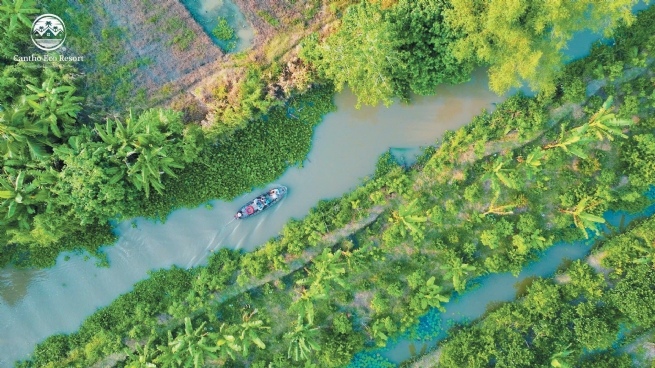Riverside urban areas, natural landscapes, geographical location, synchronous transport infrastructure and modern facilities offer great potential for Can Tho City to develop tourism into a spearhead economic sector.

Can Tho tourism highlights its strengths in urban river tourism and MICE tourism
Can Tho tourism has developed rapidly in both scale and quality in recent years, with tourist arrivals and tourism revenue growing year by year. The tourism infrastructure system has been invested and developed to expand and diversify products, improve professional, modern service quality, and engage the participation and support of all levels of authority, sectors and society. Service - tourism revenue accounts for about 8% of the city's gross regional domestic product (GRDP).
In 2022 - 2023, Can Tho City welcomed more than 11 million visitors, including 5.4 million staying tourists, with 5.2 million domestic visitors. Total tourism revenue was VND9.5 trillion. In 2023, the city had 10,329 tourism workers, including 9,068 full-time workers. 7,067 workers were trained in tourism skills and expertise.
In addition, the city currently has 636 hotels with over 11,000 rooms (of which 133 hotels are recognized as 1-5-star class, with 5,030 rooms). Can Tho is also home to 64 travel businesses and 34 tourist sites.
In 2024, although general economic performance remained rough, the city's tourism sector still achieved many important results. Increasingly rich, diverse tourism services and products are of high quality, gradually bringing the Can Tho tourism brand to more domestic and international tourists.
Can Tho defines urban river tourism strengths (featuring Cai Rang floating market) and MICE tourism (Meetings, Incentives, Conferences, and Exhibitions tourism) through the project on adjustments to the Can Tho tourism development master plan to 2020, with a vision to 2030. The city formed a central tourism cluster, Ninh Kieu - Cai Rang - Binh Thuy - Phong Dien. Ninh Kieu district, with its strengths in developing commercial and service infrastructure, should promote urban tourism, night-time products such as night markets (like Tran Phu and Ben Ninh Kieu), culinary areas, walking streets and river cruises. Binh Thuy district promotes its strengths of community tourism, cultural and historical tourism. Phong Dien district develops green tourism and eco-tourism. Cai Rang district attracts visitors with its river culture, craft villages and homestays.
On that basis, the city's tourism infrastructure has been invested synchronously in recent years. Can Tho tourism has linked with Hanoi, Ho Chi Minh City, Da Nang, Khanh Hoa, Lam Dong, Ninh Binh, Quang Ninh and other localities, or formed cluster linkages like Can Tho - An Giang - Kien Giang, Can Tho - Hau Giang, and Can Tho - An Giang - Kien Giang - Ca Mau - Bac Lieu.
Currently, the Department of Culture, Sports and Tourism of Can Tho City is developing and implementing many tourism investment and development projects and plans, like "Preserving and promoting the national intangible cultural heritage of Cai Rang floating market culture for tourism development to 2030, with vision to 2045", "Developing Can Tho ecological tourism associated with typically local cultural values", "Building and developing Can Tho specific tourism products in 2018 - 2020, with a vision to 2030", Program 16/CTr-UBND, dated December 22, 2017 on Can Tho tourism promotion in 2018 - 2020, with an eye to 2030, night-time economic development, plan for developing tourism human resources in 2021 - 2025, and digital transformation associated with Can Tho smart tourism system. At the same time, the department advised the Can Tho People's Committee to approve and call for tourism investment projects. By 2025, the tourism sector of Can Tho City will basically become a key economic sector; build highly competitive tourism products; and be an attractive destination in the region and the country. By 2030, the sector will account for a high share of the city's GRDP, and foster the development of other industries and fields. Can Tho needs to focus on implementing key tasks such as:
Researching and developing products, souvenirs and indigenous gifts and introducing the city's OCOP products to tourists: Boosting investment to further develop the night economy; developing services and products for the night economy; diversifying tourism services and products, attracting tourists to spend more and stay longer; striving to build and launch a unique tourism route and typical tourism products.
Researching and developing products, souvenirs, and indigenous gifts and introducing the city's OCOP products to tourists: Boosting investment to further develop the night economy; developing services and products for the night economy; diversifying tourism services and products, attracting tourists to spend more and stay longer; and striving to build and launch unique tourism routes and tourism products.
Mobilizing investment resources to support tourism development; strengthening connectivity and cooperation in tourism development with key localities; strengthening training and raising the quality of tourism human resources; strengthening close coordination in tourism development of all related agencies and localities; and prioritizing resources for tourism development with the motto of building Can Tho "safe - friendly - quality" tourism.
By Thanh Loan, Vietnam Business Forum